8.03 miles 3h 35m ascent 161m
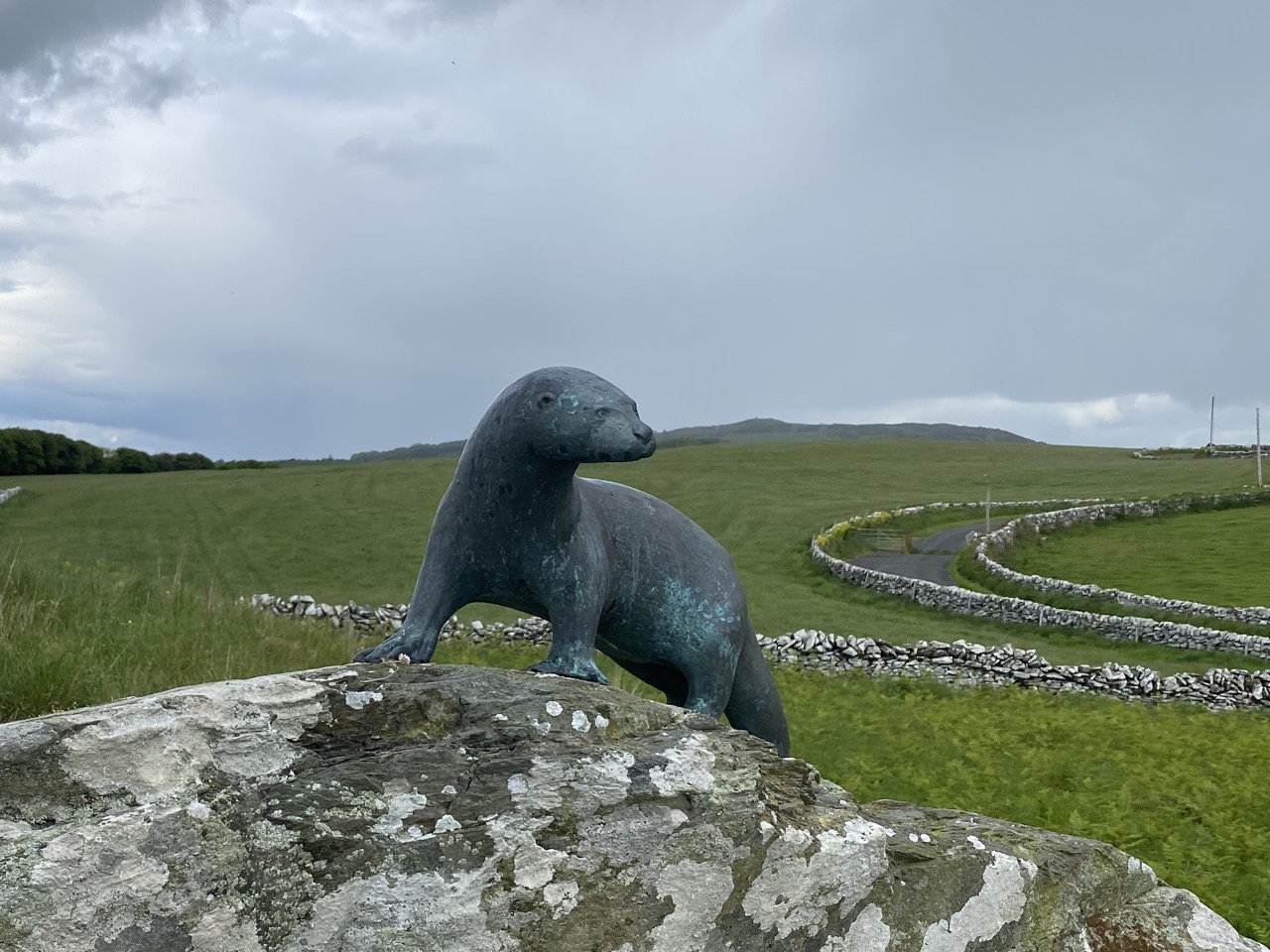
St Medan-Monreith-Myrton-Drumtroddan Stones (return)
A bronze otter stands on the lichen covered rocks of Craigengour. His head is turned to look over the Lag promontory towards the Isle of Man, on the horizon. A memorial to the author of A Ring of Bright Water. The plaque reads “Gavin Maxwell, 1914-1969, author and naturalist. Haec loca puer amavit – vir celebravit.” These places the boy loved – the man celebrated.
We had parked a few hundred metres beyond the otter, at St Medan’s Golf Club. The walk back to the otter took us above the remains of Kirkmaiden and St Medana’s Well. Medana was the maiden of ‘kirkmaiden’ and the St. Medan of the golf course, an eighth century Irish nun.
Little is known of St Medana historically but…her legend is such that she has been proposed as a patron saint for British Ophthalmologists. See Brit.J.Ophthal.(1954)38,634
Medana was an Irish lady of noble birth, blessed with great beauty and wealth, a devout maiden who had devoted herself to God. Hounded by an unwelcome suitor, she had fled to live in a remote cave on the Rinns of Galloway. But the suitor was persistent and found her refuge. She was forced to leap onto a rock to escape him but found the stone miraculously transformed into a boat, and was carried across Luce Bay. Undaunted, the Irishman followed and caught Medana beneath the cliffs of Craigengour. Thinking that her prayers for salvation had been in vain she cried out asking why he was persecuting her so. When he replied that her eyes were so beautiful he could not live without them, she plucked them out and handed them to him. He fled in horror.
She could find no water to wash the blood from her face, but it is said the saints befriended her, and a spring of water burst from the earth. When she washed her face in this water her sight was restored “to testify by its medicinal virtues the truth of the miracle.”
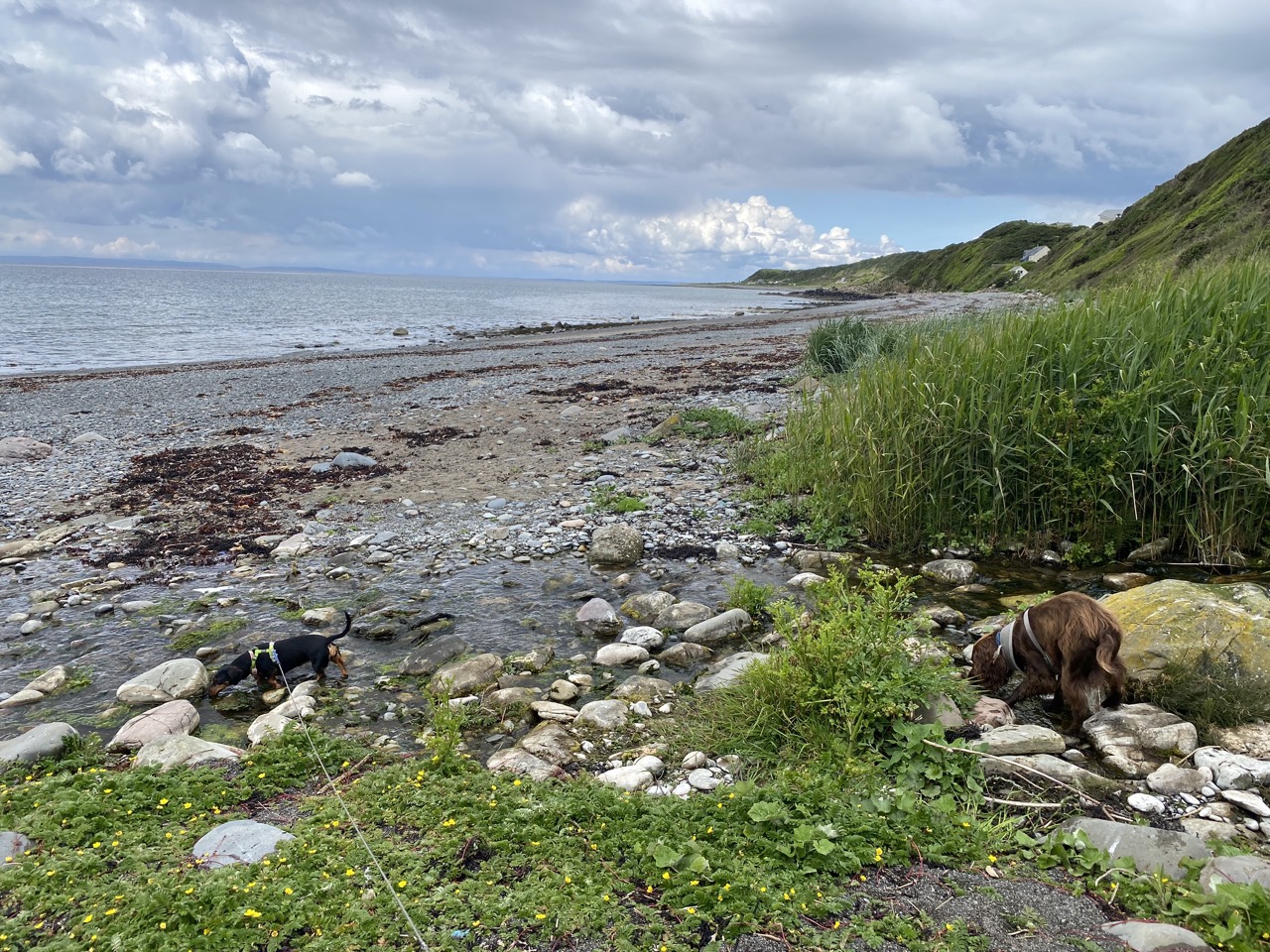
The early church felt she deserved canonisation and she is depicted along with better known saints such as Andrew, Ninian, and Columba in the stained glass windows of All Saints Church, St Andrews. Time may have stolen the truth of Medana’s life, but her name lives on in folklore and place names.
Our route took us onto Craigengour which in St Medana’s time might have sported goats since it is craigan gobhar (the crag of the goats). There were goats today but a few years ago there were other beasts competing with us for passage. There is a gate at the end now which should keep them away.
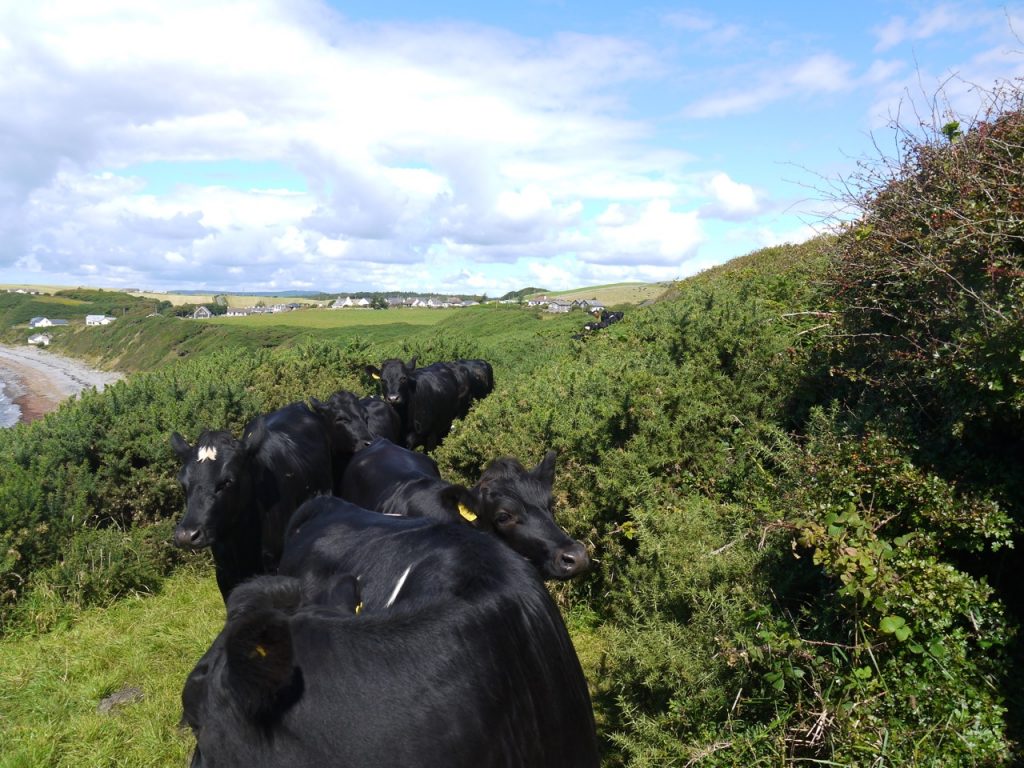
A steepish path took us down to the beach and Clark’s Burn (seen in the photograph above) was easy enough to cross. The beach was a combination of gravel and pebbles and relatively easy walking if dry. From there it was a short way to Monreith village. There is a tree-lined path beside Monreith Burn after the Mission Hall. Christy managed to find a way through the hedgerow and into the burn, but that ‘s what spaniels do. He would be wetter soon enough. A dog-leg over Blairbuie Bridge and up past the Old Lodge brought us to the end of recognisable paths.
Beyond the lodge a sign warned us to beware electric fences and there was absolutely no sign of the path marked on the OS map. We found ourselves wading through knee-high grass. Christy was bounded through it intermittently appearing and disappearing but Mabel remained hidden. I tried carrying her but she just wriggled until I put her back down in the grass. The route of the old path can be seen on satellite images and our gpx route showed we pretty much walked along it, though we couldn’t tell. By the time we reached the edge of the field my trousers were absolutely soaked and the final challenge was crossing what I took to be part of the electric fence, cunningly hung to be just too high to step over and too low to get beneath without crawling in the mud. Then a voice said “Does this help?” Audrey, lifting the cable for me.
The track into Monreith estate is covered with springy material (for horses perhaps?) but with strange markings. You can see a white line in the photograph below but sometimes there were squares sometimes curves and different colours. I was stumped but Audrey realised what it was: re-used artificial pitches, I would never have guessed.
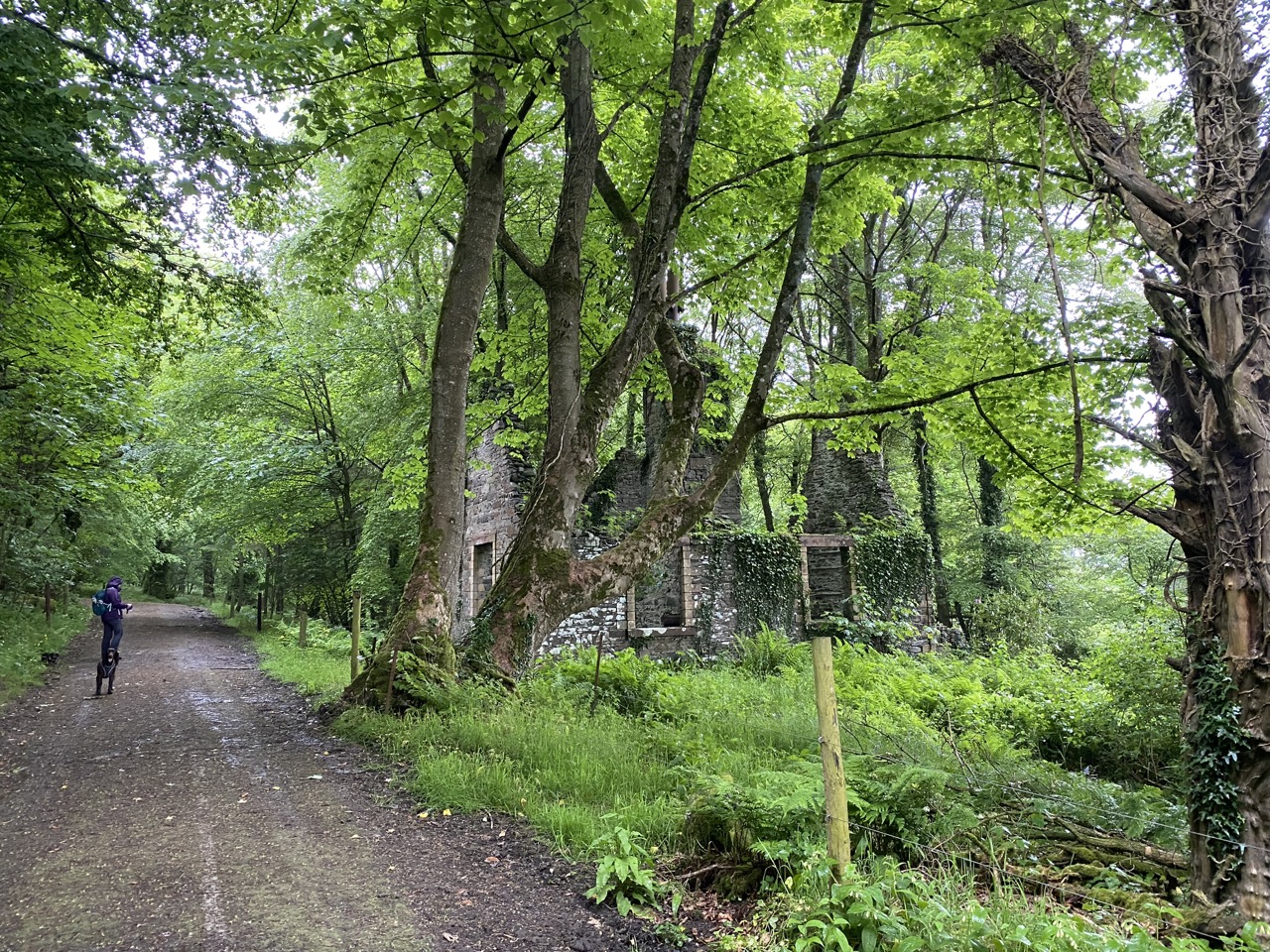
By now it was raining constantly. A broad gate proved gate difficult to open and had us shuffling under a wire with each us getting snagged. I suspect we should have climbed the gate. We soon had our first glimpse of the White Loch of Myrton through the trees. Had it not been p+$$ing down we might have gone down through the undergrowth for a better look.
The White Loch of Myrton was long believed to be unlike other lochs in the area in that “it doth never freeze’. But not everyone agreed.
This loch is very famous in many writers, who report that it never freezeth in the greatest frosts. Whether it had that vertue of old, I know not; but sure I am it hath it not now; for this same year it was so hard frozen that the heaviest carriages might have been carried over it. However, I deny not but the water thereof may be medicinal, having receaved severall credible informations, that severall persons, both old and young, have been cured of continued diseases by washing therein; yet still I cannot approve of their washing three times therein, which, they say, they must do; neither the frequenting thereof the first Sunday of the quarter, viz. the first Sunday of February, May, August and November; although many foolish people affirm, that not only the water of this loch, but also many other springs and wells have more vertue on those days than any other.
Andrew Symson ‘Large Description of Galloway’ (1684)
A tall wall, much higher than one would have for a walled garden runs by the path and presumably once part of the old castle. A ruined tower, much overgrown, was visible beyond it but we couldn’t see a way in, which is a shame since the King of the Brownies was said to have his palace under the mound on which the castle was built.
This Fairy King once appeared to the castle’s incumbent, Sir Godfrey McCulloch, to complain “My palace has been for ages in the mound on which your tower stands, and you are driving your common sewer right through my chalmer of dais (throne room). Sir Godfrey was happy to oblige the brownie and immediately ordered a change in the course of the sewer. The King of the Brownies was pleased and many years later, would return the favour by plucking McCulloch from imminent execution in Edinburgh’s Grassmarket.
As if I hadn’t said enough about St Medana already, I couldn’t help but recall one tale that said she spent some time as governess to the daughter of a Saxon King. Though we were deep in Galloway, Myrton’s name is Anglo-Saxon for the dwelling by the lake.
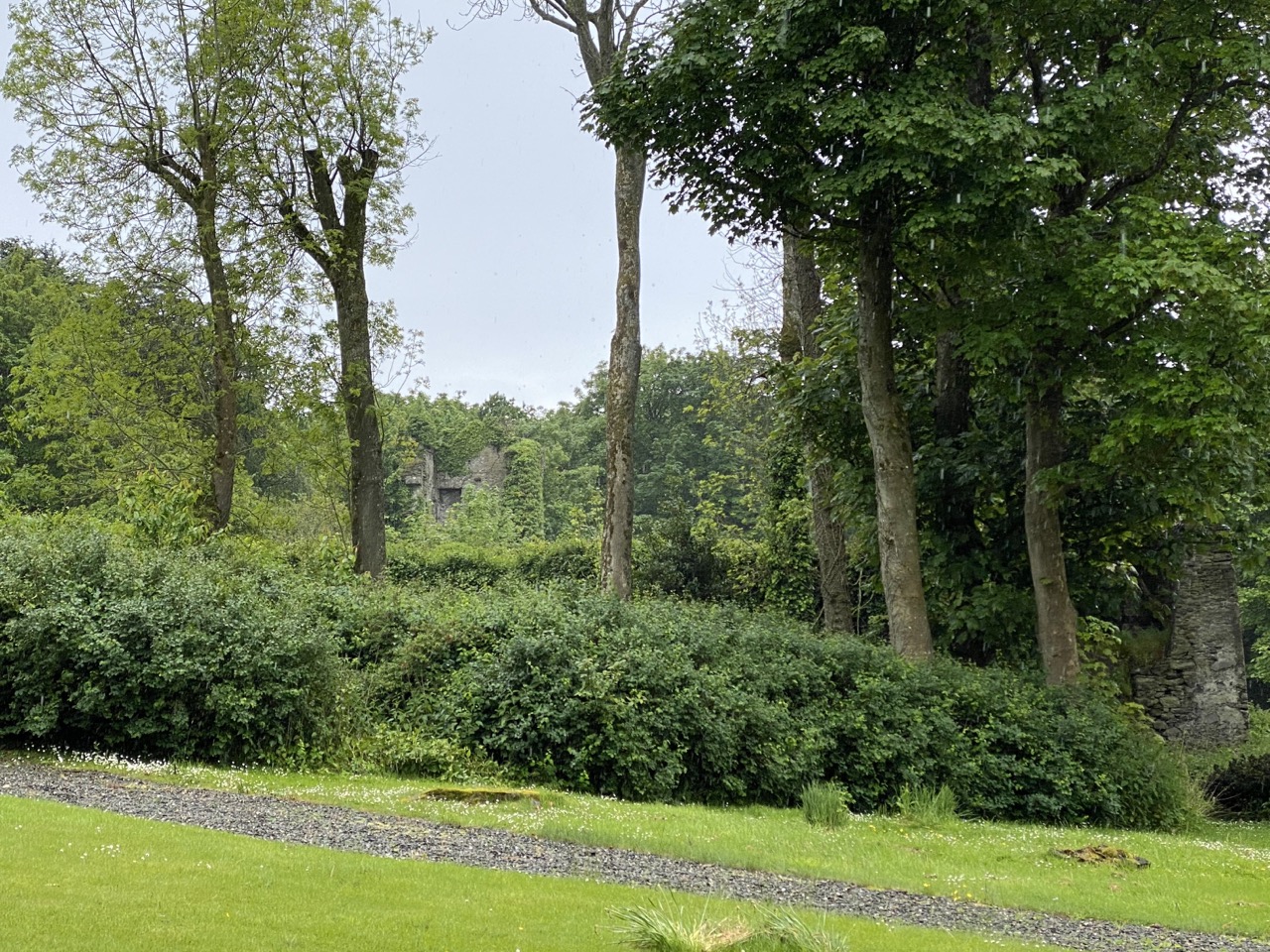
There was a strong scent of wild garlic’s we walked the forest path though the flowers had all but gone. We crossed the road and climbed to the standing stones. Human eyesight saw what canine eyesight didn’t. A hare running away ahead of us. But Mabel got the scent when we crossed the hare’s path. She went stiff then sprang after it, only to be pulled up by her harness. The look she gave me combined disappointment and disbelief that we weren’t giving chase.
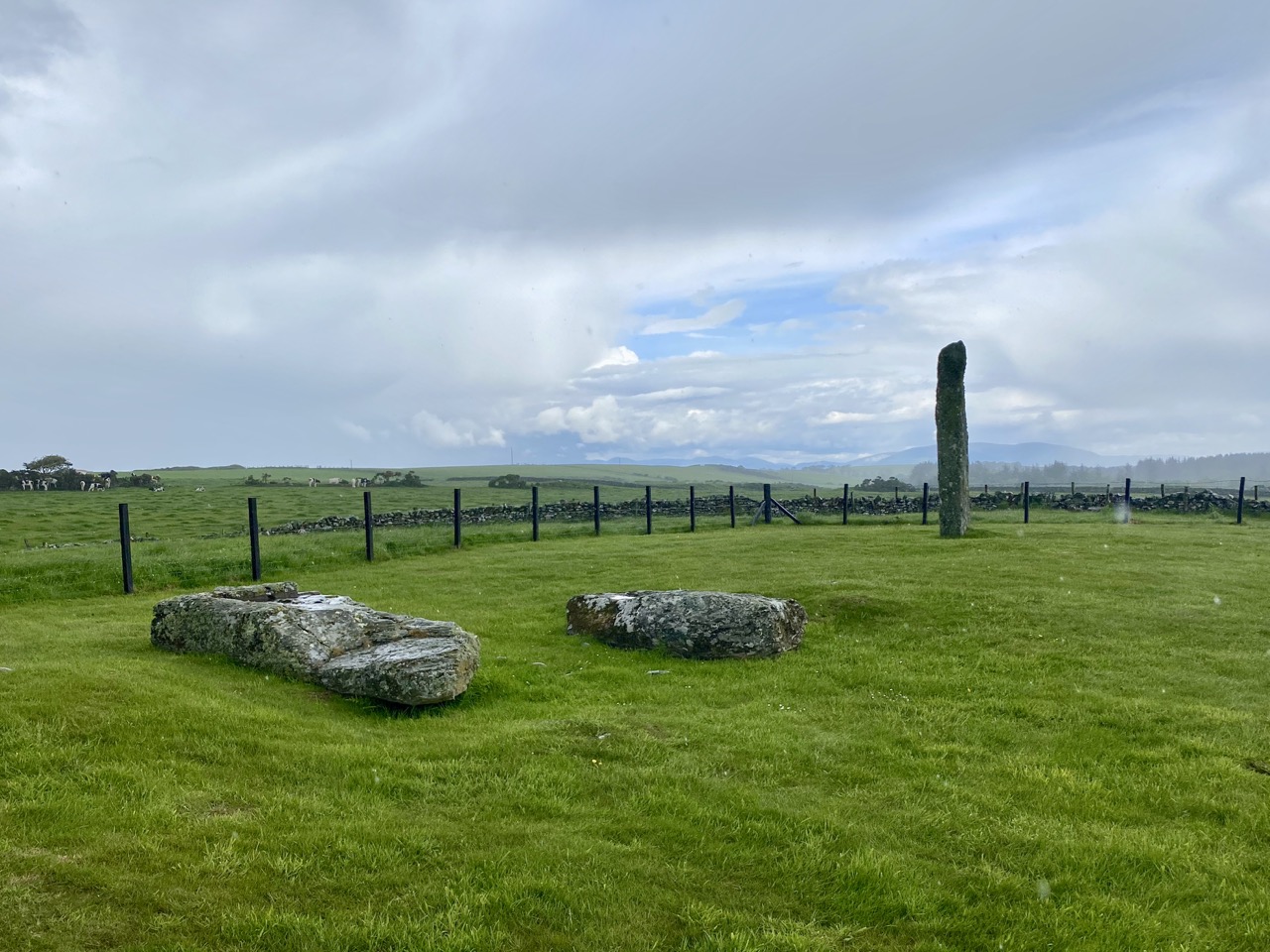
The Drumtroddan Stones stand on a small knoll, whose original name Druim Trodain, the ridge of the quarrel, leaves me wondering what had happened here. The place had surprisingly wide views even on a grey day such as we had. The stones were likely set up in the 3rd or 2nd millennium BCE. There is one standing stone and two recumbent, though one of these only fell in 2011.
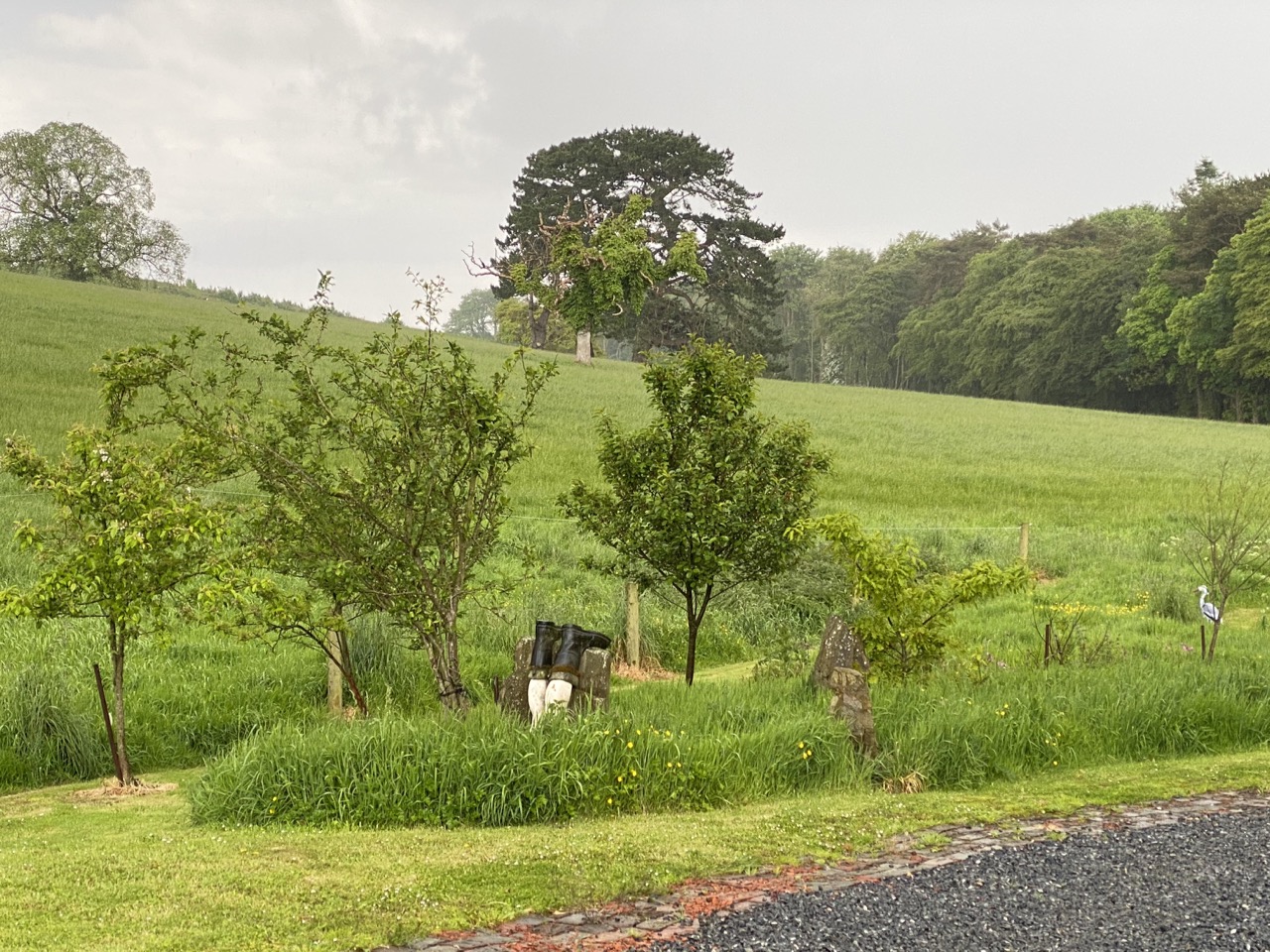
We walked down the western side of the loch and decided it would be best to avoid the two fields of long grass on the return leg.
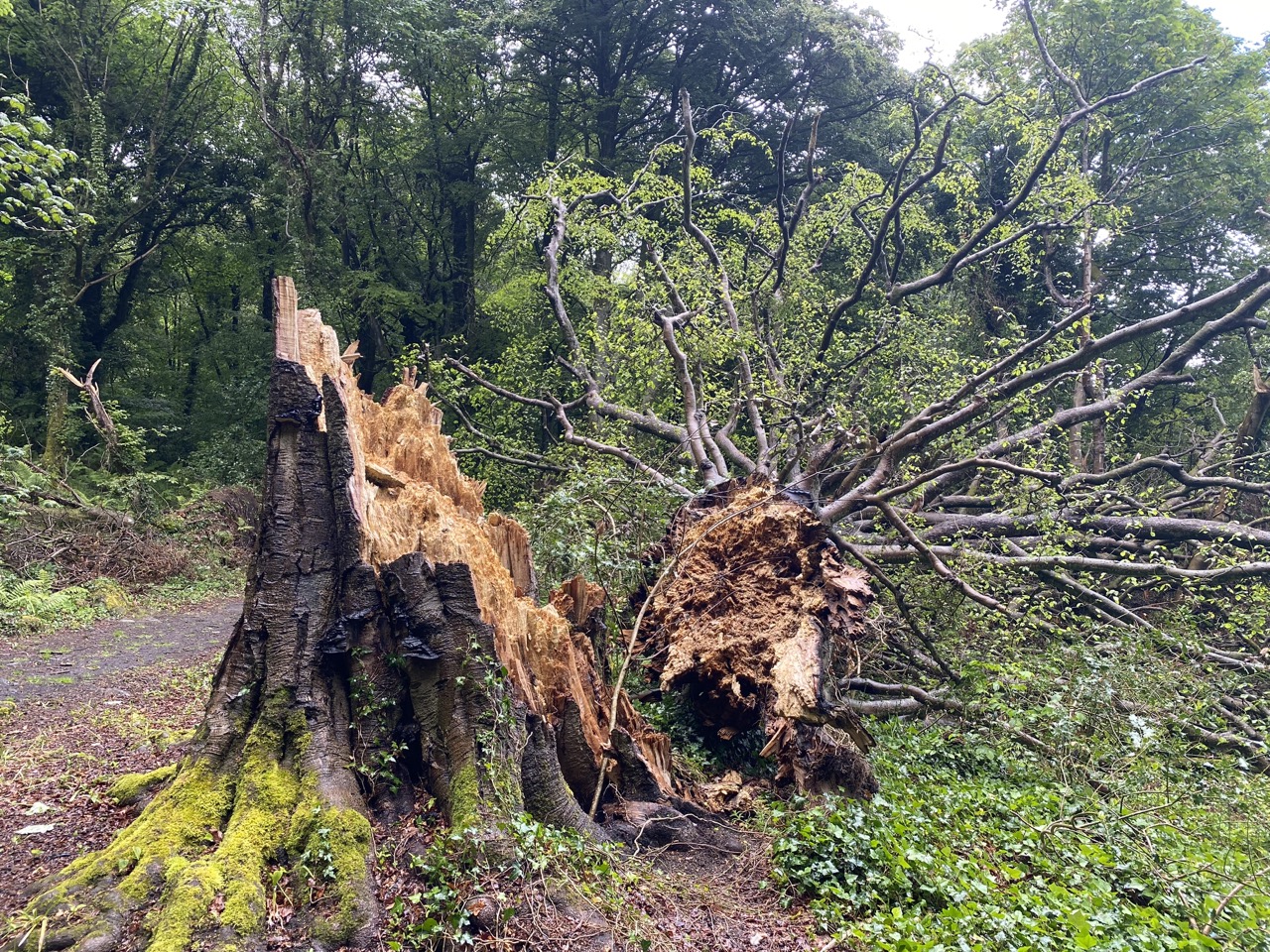
Audrey knew there was a bench by the loch but we found it taken by an angler, dry underneath a large umbrella with a GoPro on a tripod. So we had a standing coffee break sheltering beneath an old tree. I can’t say its relaxing watching rain drop falling into my coffee but the coffee tasted OK (though later it tasted very bitter indeed).
The dogs were oblivious to the deer that landed on the path ahead of us then bounded away.
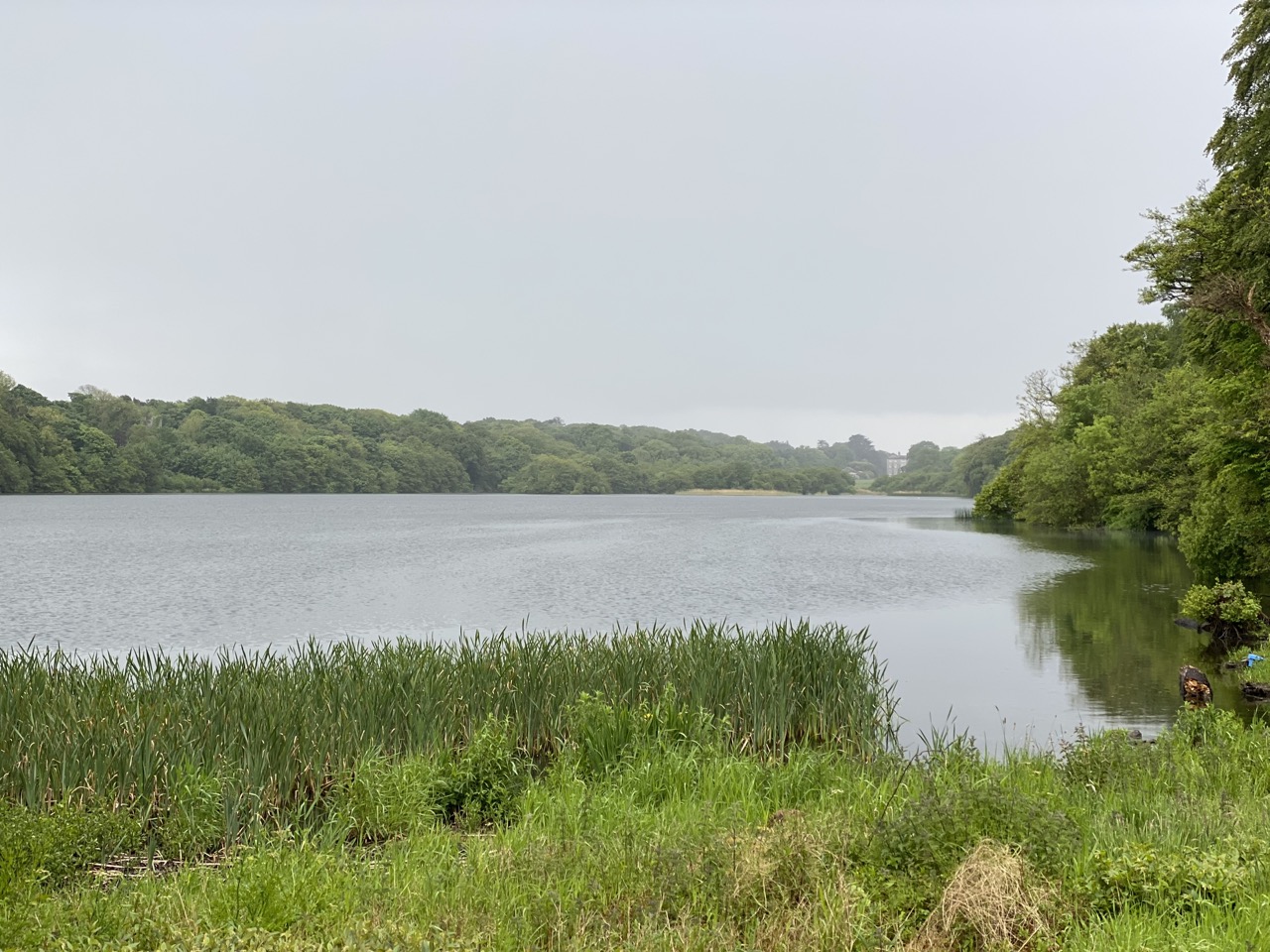
Avoiding the long grass meant road walking for a little under a mile, then across Blairbuie Bridge and along the track back to Monreith village. We must have been walking faster than we thought because the speed sign informed us we were doing 11 mph.
All four of us were well and truly soaked by the time we reached the car.
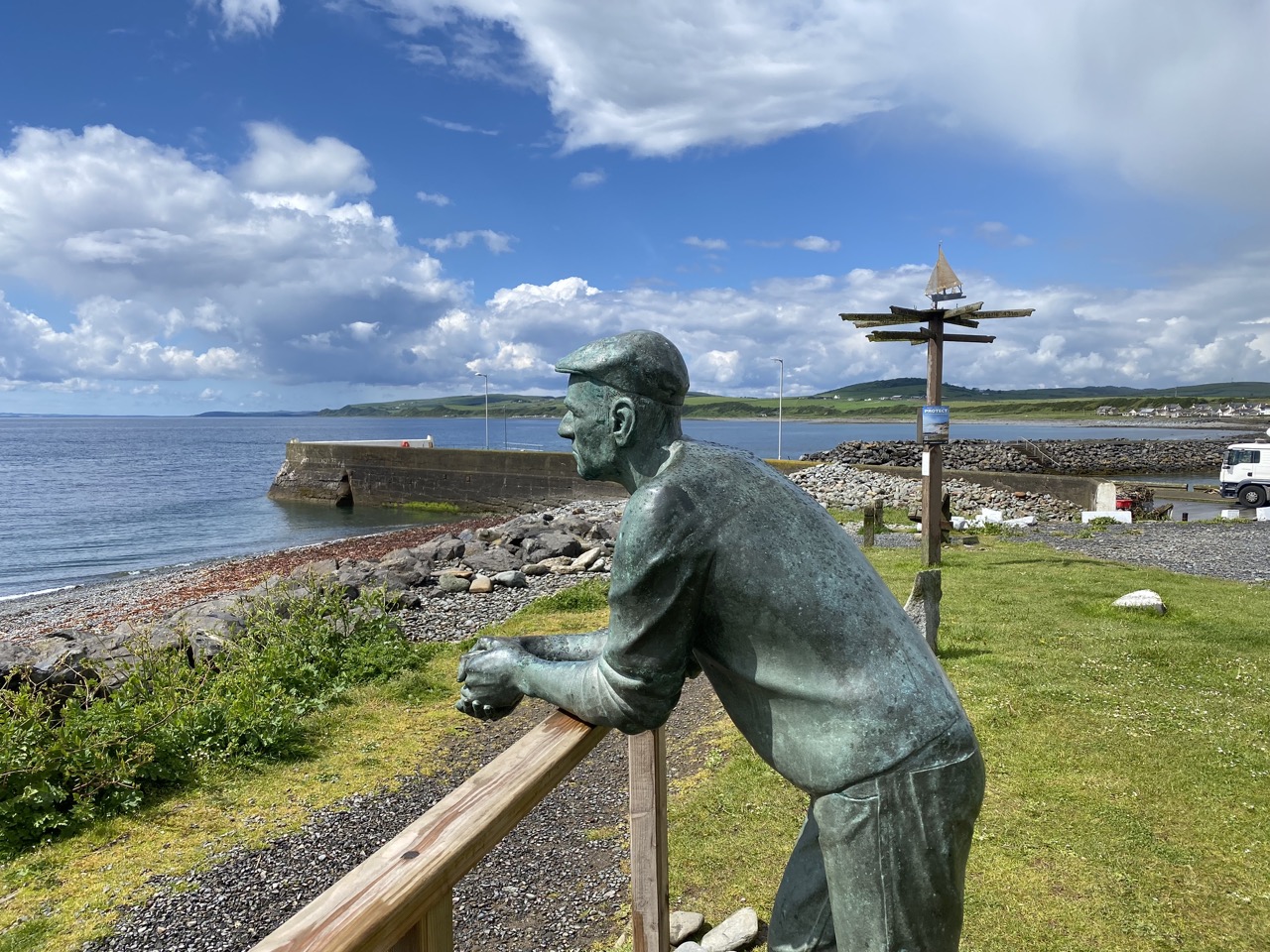
We were close to Port William so I drove along to have a look at the statue “The Man”. As you can see in the photograph, the sun came out for us.
The Man, by Andrew Brown, was commissioned to reflect the local people, their interests and their relationship with the environment in which they live. The original was concrete but began to deteriorate and was remade in bronze. He looks out to sea but could also be reading a plaque inscribed with “What is this life if, full of care, we have no time to stand and stare” from W H Davies poem.
What is this life if, full of care,
Leisure. W H Davies 1911
We have no time to stand and stare?-
No time to stand beneath the boughs
And stare as long as sheep or cows:
No time to see, when woods we pass,
Where squirrels hide their nuts in grass:
No time to see, in broad daylight,
Streams full of stars, like skies at night:
No time to turn at Beauty’s glance,
And watch her feet, how they can dance:
No time to wait till her mouth can
Enrich that smile her eyes began?
A poor life this if, full of care,
We have no time to stand and stare.

